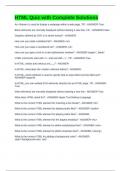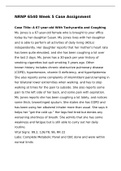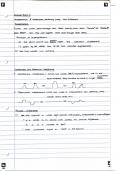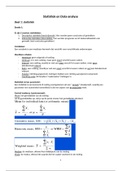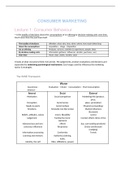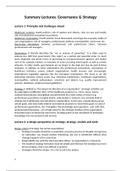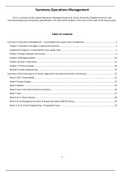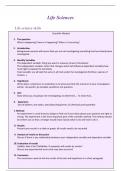Lecturers: P. de Goeij, R. Frehen
Exam: 4 questions (2 about part 1 and 2 about part 2) -> 19 October
Lecture 1: Introduction
The essential nature of investment is:
Reduced current consumption
Planned later consumption
Types of assets:
Real Assets: assets used to produce goods and services
Financial Assets: claims on real assets.
The informational role of financial markets
Playing a central role in the allocation of capital resources
o Consumption timing
o Allocation of risks
o Separation of Ownership and Management
This comes with agency issues
Corporate governance and corporate ethics is also important in financial markets
Huge accounting scandals
o Enron, Royal Ahold, AIG, Bernard L. Madoff
Analyst scandals
o Favorable analysis traded for the promise of future investment banking business
Therefore some regulation has originated:
1. Sarbanes-Oxley Act
2. Code Tabaksblat (Netherlands)
These regulations are both aimed to tighten the rules of corporate governance.
Example Consumption Timing
To choose among the possible outcomes, whe need to look at utility/indifference curves.
, An utility/indifference curve represents the investors preference for income
in two periods. These curves are constructed so that everywhere along the
same curve the investor is assumed to be equally happy.
The ‘steepness’ of the curve depends on personal preferences such as risk-
aversion.
The solution in this case gives point D.
Markets are competitive
Active Management
o Finding mispriced securities
o Timing the market
o Is it really profitable? You need to take into account the trading costs/management
fees.
Passive management
o No attempt to find undervalued securities
o No attempt to time the market
o Holding a highly diversified portfolio
o Tradingcost/management fees are much lower
Including ETFs = index trackers.
The Players
Firms – net borrowers
Households – net savers
Governments – can be both borrowers and savers
Financial intermediaries
o Investment companies
The investment banking business performs specialized services for business
such as an IPO / SEO (Morgan Stanley Guest Lecture)
Handles the marketing of securities in the primary market
o Pension funds
o Banks
o Insurance companies
,Lecture 2
The Investment Process
The Investment Process describes how a (individual or institutional) investor should go about making
decisions with regard to:
What marketable securities to invest in
How extensive the investments should be
When the investments should be made
The process consists of:
Asset allocation: choice among broad asset classes
Security Selection: choice of securities to hold within asset class
Security analysis
The steps in the investment process
1. Set investment policy (amongst other things: asset allocation and security selection
Define investor’s unique objective
Determine amount of investable wealth
State objectives in terms of risk and return
Identify potential investment categories
Investment policy should address:
Mission statement: a statement including the long-run financial goals
Risk tolerance: amount of risk that an investor is willing to bear
Policy asset mix: the long-run allocation to broad asset classes (most important decision)
Active or Passive management
o The choice mainly depends on the transaction costs.
Factors that affect risk
The maturity of an instrument; general rule: the longer the maturity is, the more risky it is
The risk characteristics and creditworthiness of the issuer or guarantor of the investment
o Example: If the counterparty is the Greek/Italian government instead of the
Dutch/German government, your investment will be riskier.
The nature and the priority of the claims the investment has on income and assets
o Stocks / Bonds
o Junior / Senior
The liquidity of the instrument and the type of the market in which it is traded.
Why doesn’t it make sense to establish an investment objective of ‘making a lot of money’?
Making a lot of money is also associated with more risk. Maximizing returns might entail inordinate
levels of risk
2. Perform security analysis
Using potential investment categories, find mispriced securities
You need to estimate the securities by a model/benchmark, otherwise you can’t
compare.
Using fundamental analysis; intrinsic value should equal discounted present value
Compare current market price to true market value
Identify undervalued securities
Timing
, 3. Construct a portfolio
Identify specific assets and proportion of wealth in which to invest
Address issues of
o Selectivity
o Timing
o Diversification
4. Revise the portfolio
Periodically repeat step 3
Revise if necessary -> incur your loss on time
o Increase/decrease existing securities
o Delete some securities
o Add new securities
5. Evaluate Performance
Involves periodic determination of portfolio performance with respect to risk and
return
Requires appropriate measures of risk and return
Trading of Securities
Securities only can be traded when they are listed on a
stock market / exchange.
Initial public offering is the process to become listed. This
process contains road shows and bookbuilding.
Research suggests that the IPO starts with underpricing,
leading to post sale returns and costs to the issuing firm.
The underpricing comes from:
The syndicate / underwriter wants (to maintain) a long
term relation with the big (institutional investors).
The underwriter guaranteed to sell a proportion of the
shares.
The IPO is associated with a positive initial return but in the
long term the performance is worse than the competitors
(which were already listed).
Characteristics of trading
Type of markets
o Direct search; this is the least organized form
o Brokered; Trading in a good is active
o Dealer; Trading in a particular type of asset increases
o Auction; most integrated form
, Types of orders
o Market; this will be executed immediately Price-Contingent Order
Bid / Ask Price -> see the limit order
book
o Price-contigent
Investors specify prices
Stop orders
1. Limit buy order: buy if and when stock may be obtained at or
below a stipulated price.
2. Limit sell order: Sell if and when to stock price rises above a
specified limit
3. Stop-loss order: the stock is to be sold if its price falls below a specified limit
4. Stop-buy order: a stock should be bought when its price rises above a limit
High Frequency Trading
Due to technology, liquidity has increased and the spreads
have decreased.
This caused a rise in High Frequency Trading (HFT). These
firms are gaming the market in doing anything they can to
be first in the market.
Takeaway from the picture
Instead of transferring your buy/sell order to the exchange,
via your briker the order could end up in a ‘darkpool’where
it could be matched with another buyer/seller without ever
ending up at exchange.
Takeaway from the book-snippets
As soon as you made clear that you wanted to buy/sell at a certain price; supply/demand would
disappear and you could not trade anymore for the listed price.
Chipotle Example It appears as that there is another player
1 4
(HFT say) ‘jumping’ in the middle of trades.
It seems as if this player knows that shares
are offered at a low price and there is
demand at a high price and takes
2
advantage of this.
5
3 Snippets: Instead of trying to match limit
orders with the highest volume, HFT firms
‘chip away’ from the high demand volume
using small supply orders and in this way
6 drive up the price


